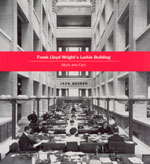Frank Lloyd Wright’s lost masterpiece

Following up on SXH’s recent post commemorating the anniversary of Frank Lloyd Wright’s birthday, another fascinating article on the life and career of the Midwest’s iconic architect appeared last month in Newsweek. In her article, contributor Cathleen McGuigan writes on the two buildings bookending the great architect’s life work. It is widely recognized that New York City’s Guggenheim Museum, the last major work undertaken by Wright in his lifetime, provided the capstone to his career, but Buffalo’s Larkin Building, “Wright’s first large scale project,” is too often forgotten. Why?
McGuigan writes:
[Opening in 1906 the building was] “revolutionary in the world of business, and within its mighty brick walls, it expressed the optimism of an era, and the excitement of a booming city.” … Outside, the imposing building was a fortress against its grimy industrial neighborhood. But inside it was airy, planned around a skylit, sun-filled, five-story atrium. The executives sat there together at long desks, not in private offices, so the 1,800 clerical workers could overlook them from the upper-floor balconies along the sides—an arrangement that symbolized the openness of the Larkin corporate culture. On the building’s exterior was inscribed the motto: HONEST LABOR NEEDS NO MASTER.
But Larkin’s soap making business, which the building housed, proved not to be as stalwart as the walls which surrounded it, and folded during the Great Depression. Abandoned, the building was finally bulldozed in 1950, despite protests by preservationists. But while McGuigan’s article laments the demise of Wright’s first masterpiece, Jack Quinan’s Frank Lloyd Wright’s Larkin Building: Myth and Fact brings it back to life with more than one hundred photographs, floor plans, maps, and diagrams. More than a historical record of the building’s conception, construction, evaluation, and finally demolition, Quinan also examines the Larkin Building as a structure at the center of economic and personal relationships, providing the definitive take on this lost treasure of American architecture.
Read McGuigan’s article online or find out more about Frank Lloyd Wright’s Larkin Building: Myth and Fact.